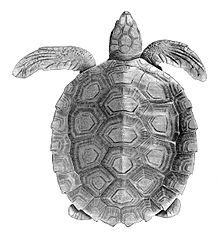- Flatback sea turtle
-
Flatback sea turtle 
Conservation status Scientific classification Kingdom: Animalia Phylum: Chordata Class: Reptilia Order: Testudines Family: Cheloniidae Genus: Natator
McCulloch, 1908Species: N. depressus Binomial name Natator depressus
(Garman, 1880)The flatback sea turtle (Natator depressus) is a sea turtle that is endemic to the continental shelf of Australia. Flatback turtles belong to the Cheloniidae, or sea turtle, superfamily and are the only species found in the genus Natator.
Contents
Taxonomy and etymology
This species is within a monotypic genus, Natator, in the Cheloniidae family; the name means "swimmer," in Latin. Depressus, the species indicator (the second part of the scientific name) means "flat" in Latin. It refers to the flatness of the Flatback's shell. The Bardi people called this animal barwanjan, and it was known to the Wunambil as madumal.[2]
Range and habitat
Flatback turtles are usually found in bays, shallow, grassy waters, coral reefs, estuaries and lagoons on the northern coast of Australia and off the coast of Papua New Guinea.
The species may feed off Indonesia and Papua New Guinea, but it nests only in Australia. Nesting occurs across the top half of Australia, from Exmouth in Western Australia to Mon Repos Conservation Park in Queensland. The most significant breeding site is Crab Island in the western Torres Strait. Breeding may also occur on the islands of the southern Great Barrier Reef, and on mainland beaches and offshore islands north of Gladstone.
Anatomy
The carapace of the adult is on average 90 centimeters (35 in) long. It is low domed, the edge is upturned and has four pairs of costal scales—fewer than other marine turtles. The upper parts are an olive-grey, while it is more pale ventrally. A single pair of scales are located at the front of the head, which also distinguish this species.[2]
Life history
Nesting
The Flatback turtle is unusual because it lays fewer but larger eggs than other sea turtle species. Like other species, its females emerge onto the beach on which they hatched more than 30 years before and make their way up the beach to lay their eggs.
Male turtles never return to shore, since mating occurs at sea, taking around 1.5 hours. The female digs a pit using her front flippers to clear away the topmost layer of dry sand. She then uses her rear flippers to dig a small egg chamber. After laying a clutch of between 50 and 75 eggs she covers them first with her hind flippers, and then flings sand back with her front flippers. Females lay eggs every 16–17 days during the nesting season—totaling 1-4 nests. They nest only every 2–3 years. There are around 54 eggs in each clutch, and the rookeries are usually small.[2]
These eggs are vulnerable to predation by dingoes, sand goannas (Varanus gouldii) and an introduced pest species—the fox. An altered ecology at known nesting sites, such as Port Hedland, has disturbed breeding behavior. Adult specimens are also found in the nets of fishing trawlers, and are still consumed by indigenous peoples across its range.[2]
Hatching
Flatback hatchlings are the largest of any turtle. Hatching is the most dangerous time for flatbacks. Guided by the low, open horizon, newborns dash for the sea. Only safety in numbers protects them from birds and crabs. However, even the sea is not safe. Sharks and fish patrol shallow waters, waiting to prey upon hatchlings. Scientists estimate only 1 of 100 turtles live to become an adult.[citation needed] However, once these turtles become adults there are very few organisms that predate them. Its survivorship curve is known as Type III because hatchlings endure high mortality rates, while adults thrive.
Ecology
Feeding
The Flatback turtle eats a variety of organisms such as seagrass, marine invertebrates including mollusks, jellyfish and shrimp and also fishes. It also consumes of soft coral, sea cucumbers and other soft-bodied creatures.[2]
Conservation
The species is considered vulnerable to extinction in Western Australia,[2] but the Red list of the IUCN regards it as data deficient and unable to be correctly assessed.[1]
The Australian flatbacks in the northwest of Kimberley face immediate threats from industrial development and need the world's attention.[3]
References
- ^ a b "Natator depressus". IUCN Red List of Threatened Species. Version 2.3. International Union for Conservation of Nature. 1996. http://www.iucnredlist.org/apps/redlist/details/14363. Retrieved 14 May 2011.
- ^ a b c d e f Burbidge, Andrew A (2004). Threatened animals of Western Australia. Department of Conservation and Land Management. pp. 110, 114. ISBN 0730755495.
- ^ Sea Turtle Restoration Project : Australia's Sea Turtles
External links
- Flatback sea turtle at the Encyclopedia of Life
- Great Barrier Reef Marine Park Authority: Flatback Turtles
- Flatback Sea Turtle @ Sea Turtle, Inc.
Cheloniidae family of turtles Genus Species of the Cheloniidae familyCaretta Chelonia Eretmochelys Hawksbill sea turtleLepidochelys Natator Flatback sea turtleKey: Phylogenetic arrangement of turtles based on turtles of the world 2010 update: annotated checklist of taxonomy, synonymy, distribution and conservation status. †=extinct not included.Order Testudines (turtles) Suborder SuperfamilySubfamily
Cryptodira Chelydra · MacrochelysCaretta · Chelonia · Eretmochelys · Lepidochelys · NatatorDermochelysDermatemydidaeDermatemysStaurotypinaeClaudius · StaurotypusBatagur · Cuora · Cyclemys · Geoclemys · Geoemyda · Hardella · Heosemys · Leucocephalon · Malayemys · Mauremys · Melanochelys · Morenia · Notochelys · Orlitia · Pangshura · Rhinoclemmys · Sacalia · Siebenrockiella · VijayachelysAldabrachelys · Astrochelys · Chelonoidis · Chersina · Cylindraspis · Geochelone · Gopherus · Homopus · Indotestudo · Kinixys · Malacochersus · Manouria · Psammobates · Pyxis · Stigmochelys · TestudoTrionychiaCarettochelyidaeCarettochelysTrionychinaePleurodira ChelidinaeChelodininaeHydromedusinaePelomedusa · PelusiosPhylogenetic arrangement based on turtles of the world 2010 update: annotated checklist. Extinct turtles not included.
See also List of Testudines families
 Portal ·
Portal ·  WikiProjectCategories:
WikiProjectCategories:- IUCN Red List data deficient species
- Natator
- Reptiles of Australia
- Reptiles of Western Australia
- Endangered fauna of Australia
- Monotypic reptile genera
- Animals described in 1880
Wikimedia Foundation. 2010.




